They might well sound strange but are real all right. Some oral histories the city throws up sound almost too dramatic to ring true
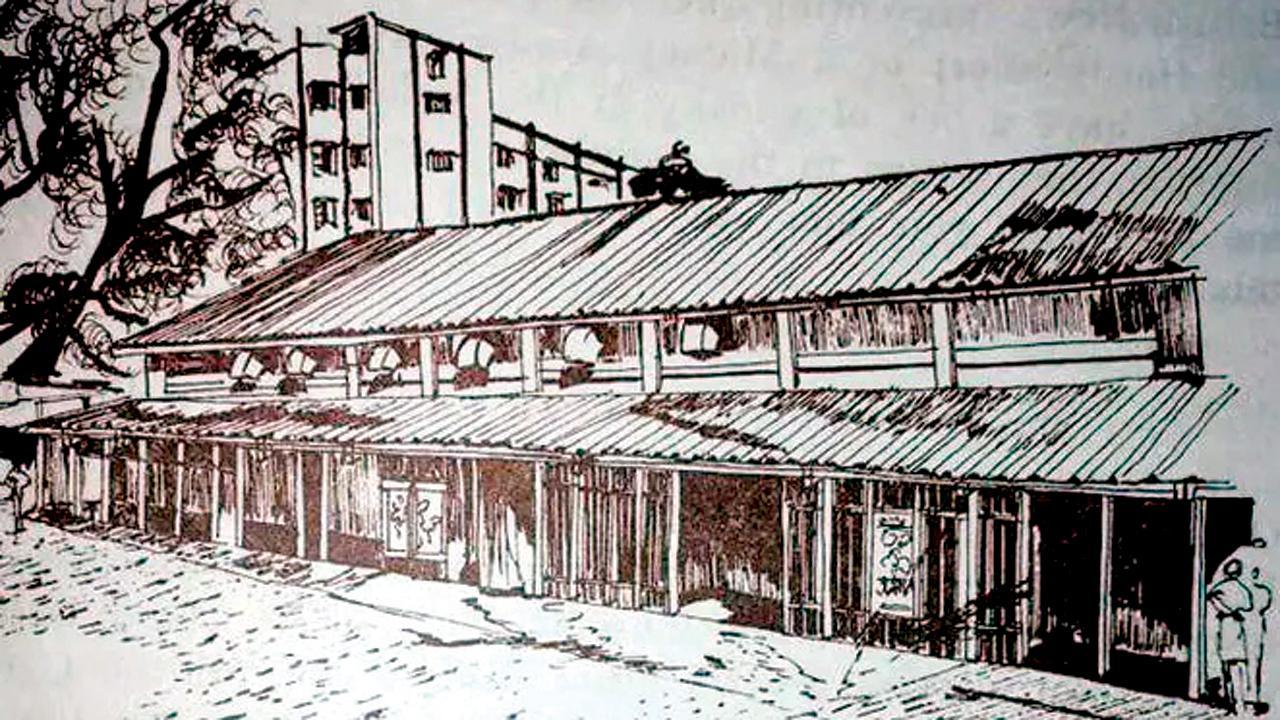
A sketch of Garrison Cinema by Dilshad Faroodi, reproduced from Ah! Colaba (1989)
 “It’s hard to believe some of the stories on your page,” one of this column’s most loyal readers recently said to me. Then quickly, gallantly, he added, “I trust you. It’s just that a few of these oral history accounts are too incredulous for words. Don’t you agree?”
“It’s hard to believe some of the stories on your page,” one of this column’s most loyal readers recently said to me. Then quickly, gallantly, he added, “I trust you. It’s just that a few of these oral history accounts are too incredulous for words. Don’t you agree?”
ADVERTISEMENT
I do. But I believe.
I believe in possibilities, in probabilities, in potential. The potential of the past to enable making sense of a world-gone-wrong in the present, which in turn might flag a better future. Whether it elicits the occasional chuckle, gasp or exclamation, research for these pages has helped understand that the outre, the outlandish—even the incredible—are less far-fetched than we think.
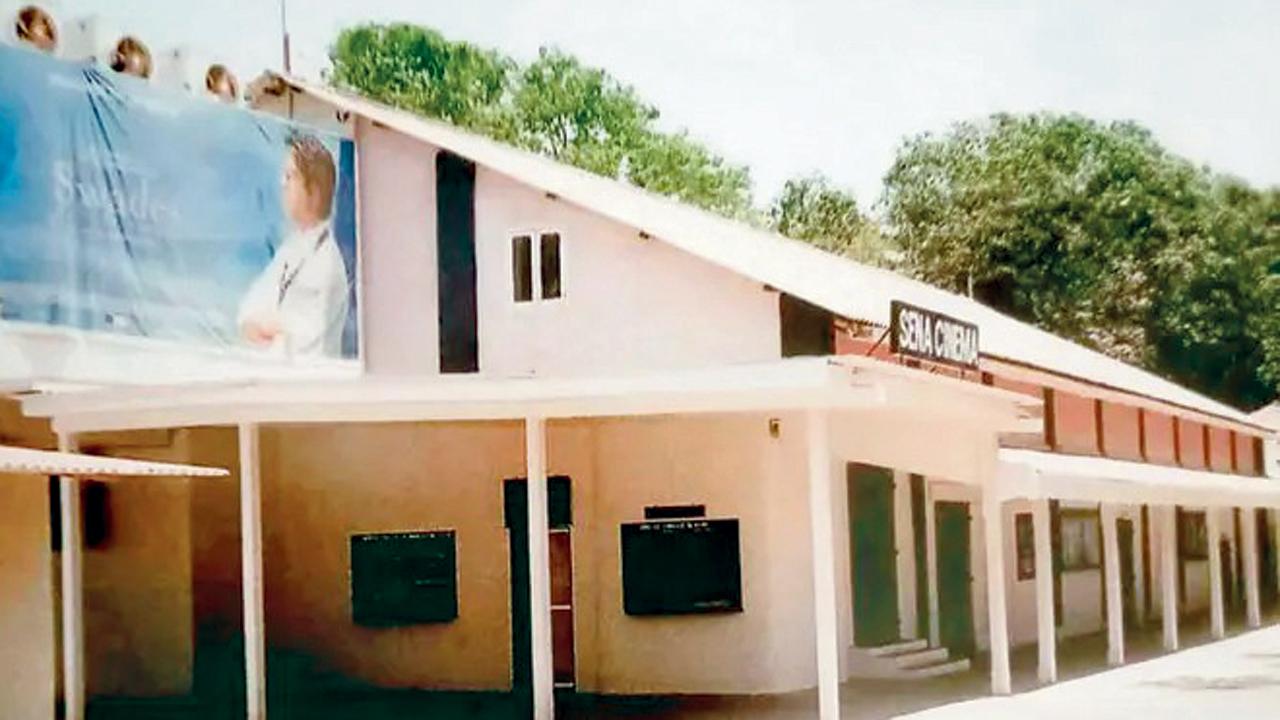 Renamed Defence, the theatre got its present name, Sena, in 2004. Pic courtesy/Swords and Shield, published by HQ M and G Area
Renamed Defence, the theatre got its present name, Sena, in 2004. Pic courtesy/Swords and Shield, published by HQ M and G Area
Appearances sure can be deceptive. Working on interviews for an article on Tardeo, I visited Dolly Malbari on the upper floor of a building mysteriously called The Reward. It shares a wall with ruins of the city’s first twin-screen theatre, Ganga-Jamuna. I had a phone conversation with the daughter-in-law of Jamshed Master, whose sisters, Alla and Tehmi, supervised each brick laid here 90 years ago. Sacrificing their jewellery as investment, the ladies were “rewarded” by tenants rushing to rent here. Petite though she was, sporting a sturdy sola topi, Alla would boom the sternest instructions from her hand-held horn to nervous labourers atop scaffolds.
“She was every bit like a dragon, the most severe disciplinarian when annoyed,” Malbari declared. I still laugh each time I pass that building, remembering the
incongruity of that situation. Alla, the pint-sized dynamo, hollering out daily orders to rough and tough workmen.
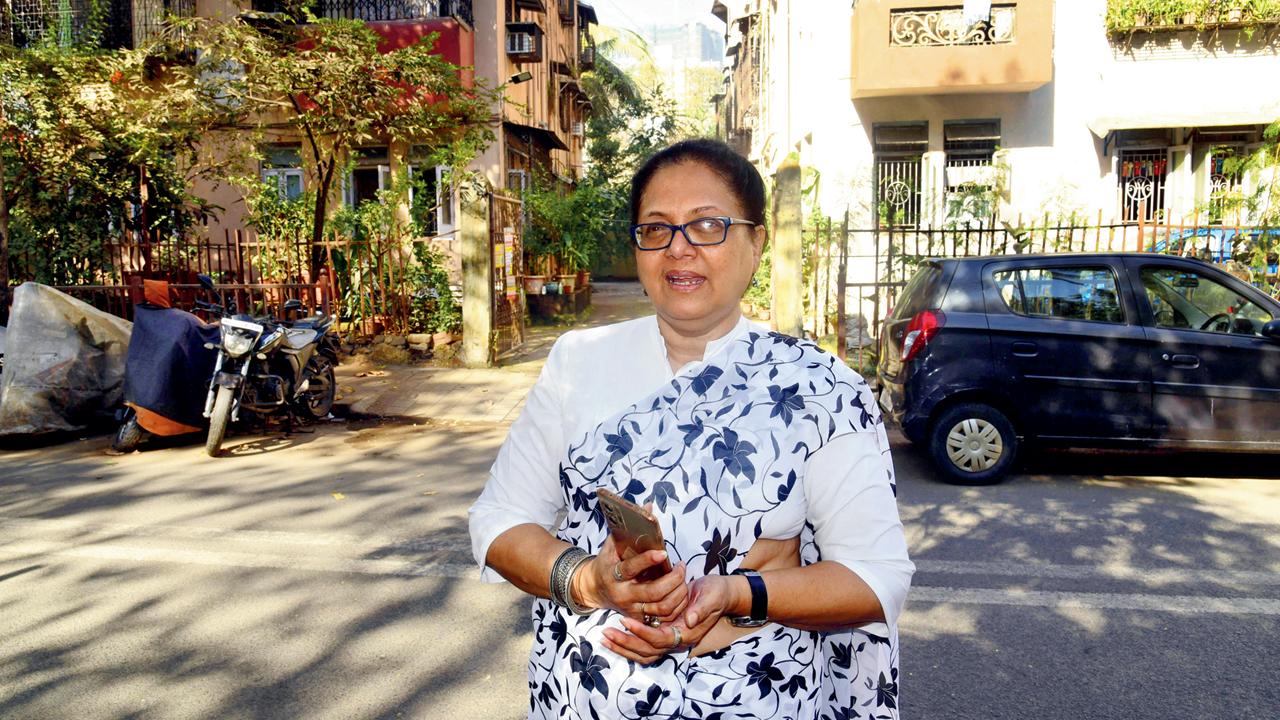 Charmaine Bocarro, lawyer and long-time resident of La Nina in Bhoiwada
Charmaine Bocarro, lawyer and long-time resident of La Nina in Bhoiwada
Another fire-breathing Bombay woman residing nearby in Sunama House at Kemp’s Corner, was socialite beauty Bapsy Pavry. The daughter of a priest, she was considered the only Indian Marchioness in history. Pavry became Marchioness of Winchester at 51, wedding the twice-married Marquess Henry William Montagu Paulet in 1952. The aristocrat husband soon strayed, falling back into the arms of his ex-girlfriend Eve Fleming, the mother of James Bond creator Ian Fleming. An enraged Pavry flew to Fleming’s home in the Bahamas for a flaming confrontation. Imagining the charged encounter is akin to watching a scene straight out of a dramatic film.
In an OTT age, going to the movies is hardly what it used to be. We love the idiosyncratic lore woven around single-screen theatres. “In exquisite irony, an Army-owned cinema has always been used more by the Navy,” observes a veteran commodore. He refers to Sena theatre near RC Church, Colaba—the old Defence cinema which was first known as Garrison. Defence was originally commissioned as a storehouse for bulk items and unserviceable spent cartridges in 1924, the year which saw landmark Colaba Garrison structures like Gun House rise. Troops were entertained under its sloping roof from 1932.
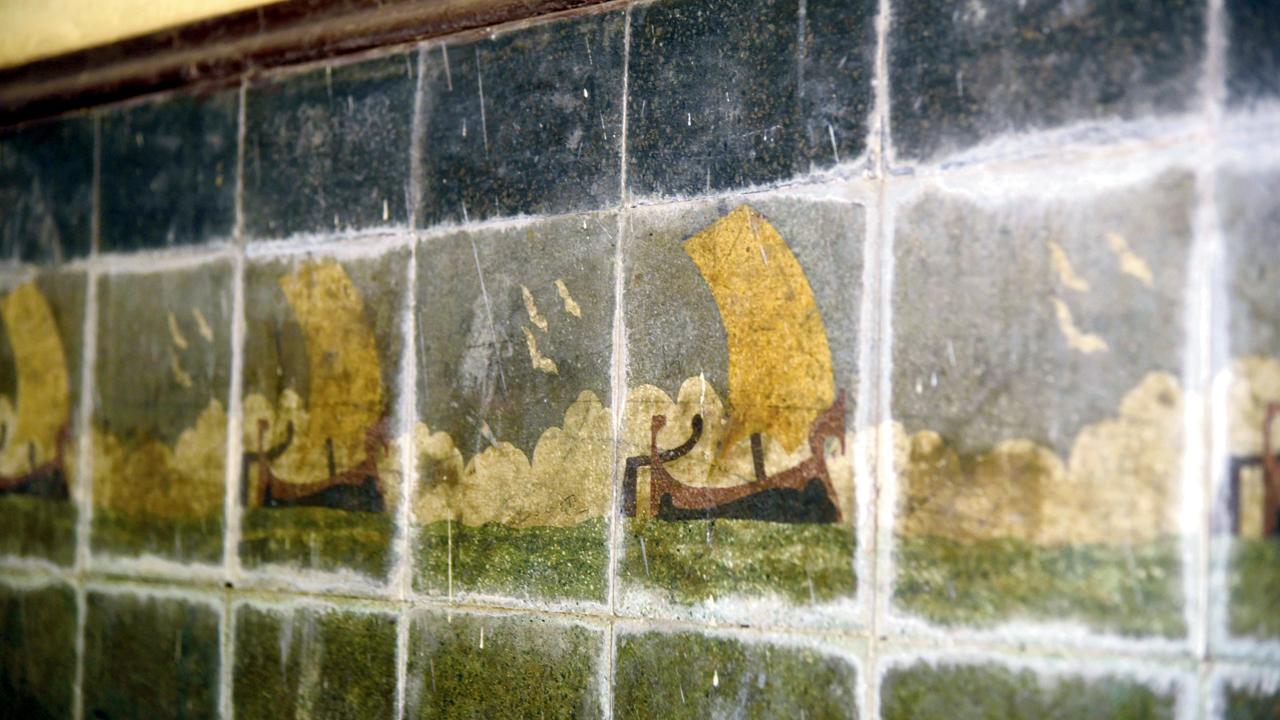 Tile detail of Christopher Columbus’ ship at the La Pinta entrance. File pics
Tile detail of Christopher Columbus’ ship at the La Pinta entrance. File pics
The recreational hub screening films from 1955 on a heritage “wall” was christened Defence in 1974. Civilians were welcomed on weekends into the space otherwise intended for the Forces. Cushioned chairs only lined the last three rows, far from bug-infested wooden front benches. Outings to Defence were never complete without samosas ingested with the ink of notebook pages wrapping them, their spicy tang washed down by sweetish sips of Vimto.
Functioning in a decrepit state for decades, the refurbished avatar, Sena, has had surround sound and air conditioning since 2004. Retired officers offer information about the hall’s journey from Garrison to Defence to Sena. “Predominantly for Hindi film re-runs, Defence had the stray English or regional language Sunday morning show,” says Commander Mohan Narayan, former curator of the Maritime History Society. “With digital prints, the Forces enjoy new releases in a daily show and two on Sundays.”
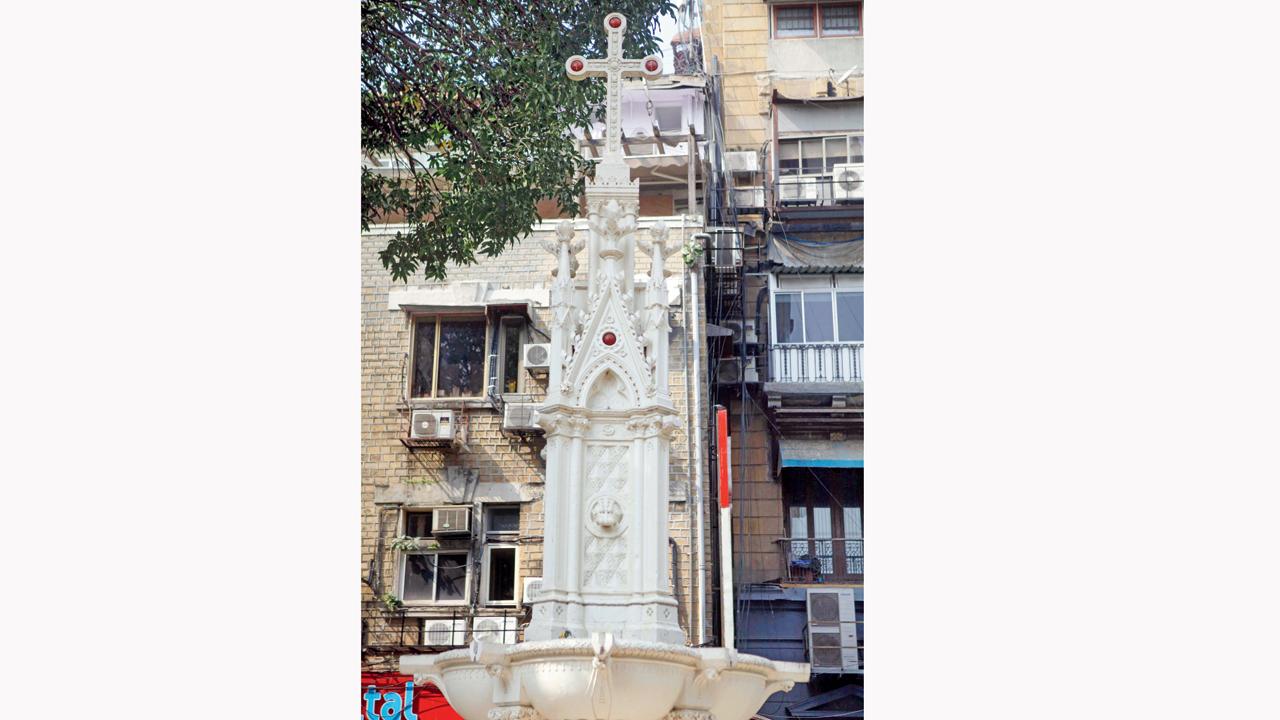 The St Thomas’ Cathedral fountain with the cross that earned a Parsi baronet his strange sobriquet. File pic
The St Thomas’ Cathedral fountain with the cross that earned a Parsi baronet his strange sobriquet. File pic
And while this next vignette isn’t strictly Bombay-based, it involves a close neighbour. The fascinating nugget came to me through Hemant Chaturvedi, whose stunning photographs documenting the last single screen cinema halls across the country are currently on display at Kala Ghoda Cafe.
How seriously fun fans can be in their adoration of an idol. A great example is The Charlie Circle, started in Adipur, Kutch, by Dr Ashok Aswani. The Chaplin impersonator’s appreciation club celebrates their hero’s birthday every April 16 with a wonderful mix of affection, awe and ethnic gusto. Dressed up with the comedian’s typical moustache, top hat and stick, excited kids travel in trucks doing the garba, cut cake and watch a Chaplin flick. Charlie Doctor, as Aswani was dubbed, prescribed anxious patients “Rx: See twice daily, Modern Times/The Tramp”. The homeopath was irrevocably Chaplin-smitten in the ’70s at a Gandhidham theatre called Oslo. Acquainted with the Swedish king and queen, its proprietor had their ambassador inaugurate his cinema.
The seemingly imperfect can prove to be just perfect upon further acquaintance. Such as the revelation of a different “Parsi time zone”. Why do the city’s fire temple clocks tick 38 minutes behind time? is an oddity often questioned. This is because Agiary timepieces chime to local, or Bombay Time, 38 minutes behind Indian Standard Time determined by the Kolkata meridian. When others point to 3.38 pm, these sturdy Burma teak specimens will always stoutly show 3 pm.
This discrepant play of pendulums is based on the logic of Gahs—phases dividing the Zoroastrian religious day—which follows five watches (sunrise, sunset, noon, 3 pm, midnight) matching local Bombay Time. Each “watch” is associated with a different divinity called Yazad. The change from the very first, Havan Gah, to the next, Rapithwan Gah, is observed in terms of Bombay Time alone. These gahs are rooted in ancient Avestan words: Havan (sunrise-12.39 pm) stems from “haoma”, which is “the time for pounding haoma”, an ingredient once used in Iranian rituals. Rapithwin (12.40-3.39 pm), meaning “mid-part”, then becomes the midday gah. Uzirin (3.40 pm-sunset) is the “high part”, or later afternoon tending to dusk. Aiwisruthrem (sunset-midnight) alludes to the “time for chanting prayer”. Ushahin (midnight-sunrise), completing the cycle, is the “time of dawn” once again.
From unmatched hours to inconsistent area pin codes… Tracking the history of the Walkeshwar area, I was amazed to find that Raj Bhavan, the gubernatorial seat since 1885 has, besides a private beach and exclusive post office, its own pin code. It is assigned 400035, while the rest of Walkeshwar falls under 400006.
Odd is good once every back story unfolds. “You’ll love these,” my friend Gitanjali texted, forwarding pictures of a trio of four-storey blocks near Bhoiwada police station. On Vasudev Pednekar Marg, in the clamorous core of the essentially Maharashtrian precinct of Parel melding with Dadar East and Naigaon, stand La Nina, La Santa Maria and La Pinta. How Columbus’ historic ships came to christen this trio of buildings makes for a marvellous story.
Striking in appearance when they rose in 1937-38, amid rows of courts and chawls for mill mazdoors, these three buildings were intended to accommodate St Xavier’s College teachers and other staff. The institution’s Spanish priests were fired by the spirit of discovery inspiring Christopher Columbus to command four Spanish transatlantic maritime voyages to the Americas. From 1936, the seminary in Parel—till it was shifted to Goregaon—cemented the city’s Jesuit-fostered educational activities.
While it is my other column, Bambai se aaya mera dost, that profiles unusual Bombay friendships, Once Upon a City also features some unlikely buddies pairing up. The man who would be King of Hindi masala films routinely phoned two Parsi girls (who were to become educationists with long years of repute) to stroll with him for after-dinner ice cream late at night in Chowpatty. Well over 80 years old when I had the chance to chat with them, the sisters, Mani and Roshan Panthaky, recalled their younger years spent in Khetwadi–where they lived in Tara Mansion and Manmohan Desai in Pratap Niwas. “Manmohan was indeed such a wonderful person,” said Mani, a former JB Petit School legend for 50 years. We met in their quiet Dadar Parsi Colony flat. Roshan, who taught at Walsingham School, explained, “We left because Khetwadi’s congestion got terrible. Initially, the Colony’s silence was deafening. In Khetwadi, on the other hand, people used to wander about till 3 in the morning.”
Behind a serene benediction in the garden of St Thomas’ Cathedral at Fort lies the tale of an intriguing sobriquet: Cowasji Cross. “Whosoever drinketh of the water that I shall give him shall never thirst”. From the Gospel of St John, this reassurance graces George Gilbert Scott’s Neo Gothic-designed fountain outside the west door of Bombay’s first Anglican Church, the Cathedral of St Thomas the Apostle. At the spot marking the city limit Point Zero, it was inaugurated on December 25, 1718, with a ten-gun salute answered by every ship in the harbour. Sir Cowasji Jehangir Readymoney funded the fountain in thanks for the protective shadow the church threw, blessing his ancestral home close beside St Thomas’ Cathedral. That gesture earned the benefactor and his donation the name, Cowasji Cross.
Which brings us to a fervent wish for this year. That although 2024 may bring little change in the powers at the helm, we the people should continue to create and appreciate such cross-community exchanges. Because we hope. Because we believe.
Author-publisher Meher Marfatia writes fortnightly on everything that makes her love Mumbai and adore Bombay. You can reach her at meher.marfatia@mid-day.com/www.meher marfatia.com
 Subscribe today by clicking the link and stay updated with the latest news!" Click here!
Subscribe today by clicking the link and stay updated with the latest news!" Click here!







